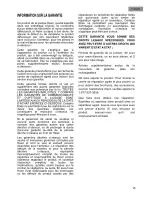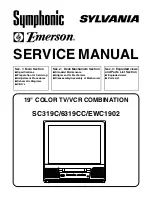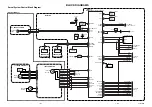
English
3
Part 1B – Mounting to the Wall (Concrete)
IMPORTANT!
For safety reasons, the concrete wall must be capable of
supporting the combined weight of the mount and the display. The manufacturer
takes no responsibility for failure caused by walls of insuffi cient strength.
1.
Place the mounting template against the wall in the desired location. Make sure
the template is level.
2.
Drill two 10 mm (3/8”) holes in the wall using the template as a guide. Remove
any excess dust from the holes (see Fig. 3).
3.
Remove the template from the wall and insert a concrete anchor (C) into each
hole so that it is fl ush with the concrete surface. A hammer can be used to
lightly tap the anchors into place if necessary.
NOTE:
If the concrete wall is covered by a layer of plaster or drywall, the
concrete anchor must pass completely through the layer to rest fl ush with the
concrete surface.
4.
Place the wall plate against the wall over the inserted anchors and attach it
using the lag bolts (A) and lag bolt washers (B) provided (see Fig. 4).
Do not
over-tighten these bolts and do not release the wall plate until both
bolts are in place.
Ensure that the wall plate remains level after both bolts are secured.
Part 2 – Attaching the Mount Arms to the Display
IMPORTANT!
Use extra care during this part of the installation. If possible, avoid placing your display facedown
as it may damage the viewing surface.
NOTE:
This mount comes with a selection of different screw diameters and lengths to accommodate a wide variety
of display models. Not all of the hardware in the kit will be used. If you cannot fi nd the appropriate screw size in the
kit provided, consult the manufacturer of your display for more information.
1.
Determine the correct length of screw to use by examining the back of your display:
A.
If the back of your display is fl at and the mounting holes are fl ush with the surface, you will use the shorter
screws (D, F, or H) from the hardware kit.
B.
If the back of your display is curved, has a protrusion, or if the mounting holes are recessed, you will need
to use the longer screws (E, G, or I) and may also need to use the spacers (K).
2.
Determine the correct diameter of screw to use by carefully trying one of each size (M4, M6 and M8) from the
hardware kit.
Do not force any of the screws – if you feel resistance stop immediately and try a smaller
diameter screw.
3.
Attach the mount arms to the back of your display using the screws identifi ed in Steps 1 and 2 (see Fig. 5):
Fig.5
For displays
with fl at
backs.
For displays
with curved
or recessed
backs.
A.
If you are using the M4 or M6 screws you will also need to use the M6 washers (J). M8 screws do not
require washers.
B.
If you are using the longer screws on a display with a curved or recessed back, you may also need to use
the spacers (K). Use one spacer or two spacers stacked as needed.
Only use a spacer if necessary.
Fig.3
Fig.4
Continues on next page...






















